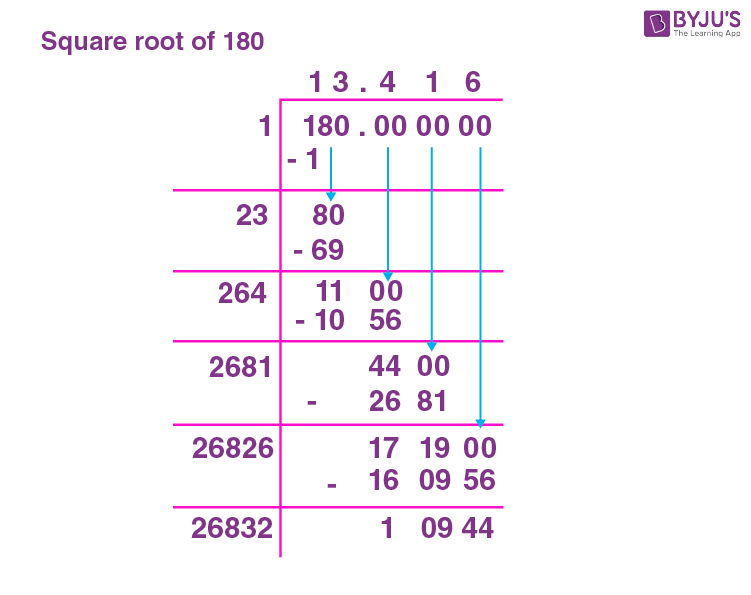The square root of 180 is irrational. The approximate value of square root of 180 is 13.41. If there exists a number “r” such that “r × r” = 180, then “r” will be called as the square root of 180 and 180 will be termed as the perfect square number. Note that “r” can be an integer. The methods to find “n” are either by prime factorisation method, long division method or repeated subtraction method. All the details on these methods are detailed in this article.
Consider the number 14 × 14 = 196 and 13 × 13 = 169. 180 lies between 196 and 169. So the square root of 180 lies between 14 and 13 as 180 is not a perfect square number. Hence, the square root of 180 is also not a perfect integer. Therefore, √180 is an irrational number. You can refer to the 1 to 50 Square and Square root List.
Note the Following:
- The Square root of 180 = 2√180 = √180 where ‘√’ is the radical, and 180 is the radicand and 2 is the index.
- Exponential Form of Square root of 180 = 1801/2
- Solution for √180 ≈ 13.41
- The square root of 180 is Irrational = True
What is the Square root of 180?
The square root of 180 is13.41, as the square root of 180 is irrational.
|
√180 = 6√5 = irrational =13.41 |
How to Find the Square root of 180?
There are three methods to find the Square root of 180
- Prime Factorisation method
- Long Division method
- Repeated Subtraction method
Square root of 180 by Prime Factorisation Method
In the prime factorization method, 180 is divided by prime factors. Starting with 2.
The prime factors of 180 are 2, 3 and 5.
180 = 2 × 2 × 3 × 3× 5
If we had to group the same prime numbers of two, then only 2 and 3 can be grouped.
180 = 2 × 2 × 3 × 3 × 5
√180 = √((2 × 2) × (3 × 3) × 5 )
√180 = (2 × 3) × √5 = 6√5
The division on 180 using prime factors is given below;
|
2 |
180 |
|
2 |
90 |
|
3 |
45 |
|
3 |
15 |
|
5 |
5 |
|
× |
1 |
Square root of 180 by Long Division Method
To understand the long division method, follow the below mentioned detailed steps;
Step 1: Group the given number into pairs.
Step 2: Divide the first pair, using the divisor, such that the product is less than or equal to.
Step 3: Continue the division, by bringing the next pair
Step 4: The first divisor in the next division to be (Divisor of first division + quotient of first division) such that
d1 × 1 =
d2 × 2 =
d3 x 3 =
And so on.
Step 5: If the division is complete with the remainder as zero, then the quotient will be the square root. Else the number is not a perfect square number.
Applying the above steps to 180
Pairing 1 and 50
The squares are
1 × 1 = 1

No further division is possible and the remainder is non- zero(11). Hence 180 does not have a perfect square. Therefore 180 is an irrational number which is 6√5.
Square root of 180 by Repeated Subtraction Method.
When 180 is repeatedly subtracted by odd numbers, i.e., 180 – 1 = 179. Now 179 – 3 = 146, then with 7 and so on. When this repeated subtraction results in zero at any point, then 180 will be a perfect square number. If the subtraction results in a negative number, then 180 will not be a perfect square number, and hence it won’t have a square root.
The table below shows repeated subtraction for the given number 180.
|
Step 1 |
180 |
– |
1 |
= |
179 |
|
Step 2 |
179 |
– |
3 |
= |
176 |
|
Step 3 |
176 |
– |
5 |
= |
171 |
|
Step 4 |
171 |
– |
7 |
= |
164 |
|
Step 5 |
164 |
– |
9 |
= |
155 |
|
Step 6 |
155 |
– |
11 |
= |
144 |
|
Step 7 |
144 |
– |
13 |
= |
131 |
|
Step 8 |
131 |
– |
15 |
= |
116 |
|
Step 9 |
116 |
– |
17 |
= |
99 |
|
Step 10 |
99 |
– |
19 |
= |
80 |
|
Step 11 |
80 |
– |
21 |
= |
59 |
|
Step 12 |
59 |
– |
23 |
= |
36 |
|
Step 13 |
36 |
– |
25 |
= |
11 |
|
Step 14 |
11 |
– |
27 |
= |
-16 |
Since the difference does not become zero but is -16, 180 is not a perfect square number and hence it does not have a perfect square root. The root lies between the numbers 13 and 14, resulting in a decimal root.
Video Lessons
Visualising square roots

Finding Square roots

Related Articles
- Square Root
- What is Square root?
- Finding Square roots
- Finding Square root with Example
- Square root Calculator
- Squares and Square roots.
Solved Examples
- Which number greater than 180 is a perfect square?
196, which is greater than 180, is a perfect square number. 14 is its perfect square root.
- What is the square of 180?
180 square is 32400.
1802 = 180 x 180 = 32400.
Comments